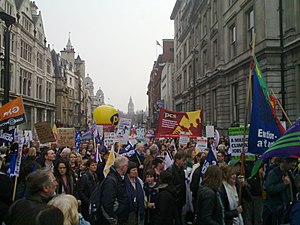Anti-austerity movement in the United Kingdom
| Anti-austerity movement in the United Kingdom | |
|---|---|
| Part of the impact of the Great Recession | |

Demonstrators march along Whitehall on 26 March 2011
|
|
| Date | 10 November 2010 – present |
| Location | United Kingdom |
| Causes | Austerity |
| Methods | Demonstrations, strike action, sit-ins, occupations, rioting |
The anti-austerity movement in the United Kingdom saw major demonstrations throughout 2011. While agreeing that the country faced a financial crisis, organisations including some UK trade unions, argued that the Conservative-Liberal Democrat coalition government was pushing deep spending cuts rapidly and without proper consultations or consideration for the impact on the public. They believed that most of the government cuts were designed to target the working class, while big businesses, and financial businesses, in particular businesses with connections to British MPs, were going unpunished whilst avoiding paying any tax, despite their perception that the latter was the main reason for the financial crisis and the subsequent recession.
Earlier demonstrations led to a major event, the March for the Alternative, on 26 March 2011 coordinated by the Trades Union Congress with a crowd of 500,000 people taking to London's streets.
Further smaller demonstrations led up to a second big event, J30, on 30 June. This was marked by major rallies in London, Brighton, Sheffield, Birmingham and Newcastle, and significant strike actions by teachers and public sector workers.
In May 2010, the United Kingdom general election resulted in no political party achieving sufficient support to form a working majority government on their own. For this reason, the Conservative Party and Liberal Democrats entered into a coalition government together. The Conservative leader David Cameron became Prime Minister whilst Liberal Democrat leader Nick Clegg became Deputy Prime Minister.
...
Wikipedia
